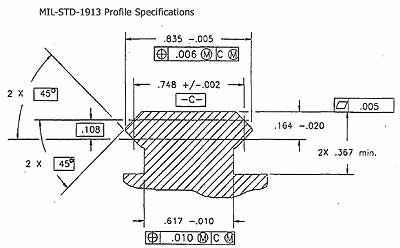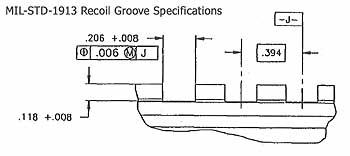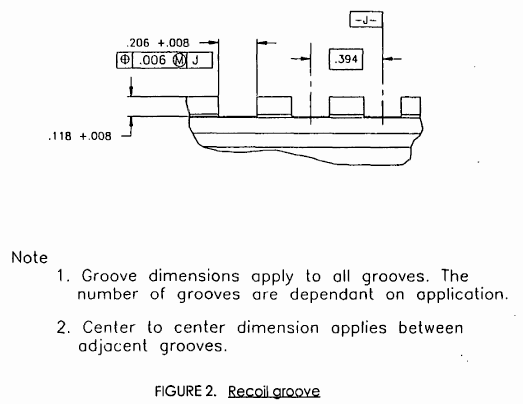There have been some discussion lately about Picatinny and Weaver Rails. Here is a little bit of information I have found on them:
Picatinny Rail
http://en.wikipedia.org/wiki/Picatinny_rail
In order to provide a stable platform, the rail should not flex as the barrel heats and cools; this is the purpose of the spacing slots: they give the rail considerable room to expand and contract lengthwise without distorting its shape. The Picatinny locking slot width is 0.206 in (5.23 mm). The spacing of slot centers is 0.394 in (10.01 mm) and the slot depth is 0.118 in (3.00 mm). The only differences between the Picatinny rail and the similar Weaver rail are the size of these slots and the fact that they are standardized. Weaver rails have a slot width of 0.180 in (4.57 mm), but are not necessarily consistent in the spacing of slot centers. Some accessories are designed to fit on both Weaver and Picatinny rails; but most Picatinny devices will not fit on Weaver rails.
Weaver Rail
http://en.wikipedia.org/wiki/Weaver_rail_mount
The only difference between the Picatinny rail and the Weaver rail is the size of these slots, although many rail-grabber-mounted accessories can be used on either type of rail. Weaver rails have a slot width of 0.180 in (4.572 mm), but are not necessarily consistent in the spacing of slot centers. The Picatinny locking slot width is 0.206 in (5.232 mm) and the spacing of slot centers is 0.394 in (10.008 mm). Because of this, with devices that use only one locking slot, Weaver devices will fit on Picatinny rails, but Picatinny devices will not always fit on Weaver rails. The other difference is that Weaver rails are continuous, while Picatinny rails are cut by the slots (like a dotted line) to neutralize expansion caused by barrel heating.
The article below is from Brownells:
When you are looking through the Brownells Catalog, there are many different parts and accessories that use the words Picatinny and Weaver to describe what they are compatible with. Just what is a Picatinny Rail anyway? And how is it different from a Weaver? It will be beneficial to look at the origin of the Picatinny system first.
The “Picatinny Rail” is a term that has evolved in the firearm industry from a military standard, specifically MIL-STD-1913 (AR) which was adopted on February 3, 1995. The title of the publication is “Dimensioning Of Accessory Mounting Rail For Small Arms Weapons” and this document specified exactly what the dimensions and tolerances were for any mounting systems that were to be submitted for acceptance by the military. The term “Picatinny” comes from the place of origin for this system, the Picatinny Arsenal located in New Jersey. MIL-STD-1913 specifies the dimensions required for consideration, including length, width, height, and angles and the tolerances allowed for each measurement. The key distinction of the MIL-STD-1913 lies in the specification for the profile and the recoil groove.

Source: MIL-STD-1913 (AR) 3 February 1995

Source: MIL-STD-1913 (AR) 3 February 1995
What are the differences between the “Picatinny” and the “Weaver” systems? The profile of the two systems is virtually identical. Depending on the quality of the machining done by the manufacturer, the two systems should be indistinguishable from the profile. The key difference lies in the placement of the recoil grooves and with width of the grooves. MIL-STD-1913 (Picatinny) grooves are .206” wide and have a center-to-center width of .394”. The placement of these grooves has to be consistent in order for it to be a true “Picatinny” MIL-STD system. Weaver systems have a .180” width of recoil groove and are not necessarily consistent in a center-to-center measurement from one groove to the next. In many instances, a Weaver system has a specific application that it is machined for, so interchangeability is not necessarily an issue. A MIL-STD-1913 system must adhere to the specifications listed above in order for it to be considered MIL-STD, since the military desires uniformity in the recoil grooves to allow for different systems to be mounted on the weapon with no concern for compatibility.
Now, what does this mean to you? Boiled down, it means that accessories designed for a Weaver system will, in most cases, fit on a “Picatinny” system. The reverse, however, is probably not the case. Due to the larger recoil groove, “Picatinny” accessories will not fit a Weaver system. There are, of course, exceptions to every rule, but for a good rule-of-thumb, “Picatinny” won’t fit Weaver, but Weaver will fit “Picatinny”.
1 Guest(s)

 Register
Register Log In
Log In Home
Home
 Offline
Offline







 Happyness is a Hot DW and a pile of used brass!!! Rich
Happyness is a Hot DW and a pile of used brass!!! Rich
